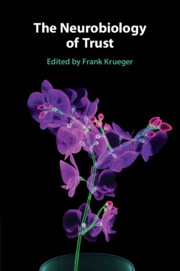Book contents
- The Neurobiology of Trust
- The Neurobiology of Trust
- Copyright page
- Dedication
- Contents
- Figures
- Tables
- Contributors
- Abbreviations
- Introduction
- Part I Fundamental Level of Trust
- Part II Neuropsychological Level of Trust
- Chapter 5 Trust and Risk
- Chapter 6 Trust and Emotion
- Chapter 7 Trust and Reputation
- Chapter 8 Trust and Learning
- Part III Neurocharacteristic Level of Trust
- Part IV Neuromolecular Level of Trust
- Part V Neuropathological Level of Trust
- Index
- References
Chapter 7 - Trust and Reputation
How Knowledge about Others Shapes Our Decisions
from Part II - Neuropsychological Level of Trust
Published online by Cambridge University Press: 09 December 2021
- The Neurobiology of Trust
- The Neurobiology of Trust
- Copyright page
- Dedication
- Contents
- Figures
- Tables
- Contributors
- Abbreviations
- Introduction
- Part I Fundamental Level of Trust
- Part II Neuropsychological Level of Trust
- Chapter 5 Trust and Risk
- Chapter 6 Trust and Emotion
- Chapter 7 Trust and Reputation
- Chapter 8 Trust and Learning
- Part III Neurocharacteristic Level of Trust
- Part IV Neuromolecular Level of Trust
- Part V Neuropathological Level of Trust
- Index
- References
Summary
Forming impressions of trustworthiness about social partners is critical to making adaptive decisions in novel social environments and maintaining healthy interpersonal relationships. However, such impressions can also be biased and lead to maladaptive or harmful trust decisions. In this chapter, we discuss the neurobiological underpinnings of how initial impressions of one’s trustworthiness and the reputation we assign them inform social decision making. We first focus on rapid initial impressions of perceived trustworthiness and how they can be biased by social and contextual information. Next, we review how trustworthiness reputations are learned through novel social interactions and are shaped by prior knowledge, particularly in the context of established interpersonal relationships. Here, we focus primarily on the role of corticostriatal neural systems. Finally, we present emerging avenues of research on how impressions of trustworthiness and acquired reputations guide real-world decision making and are impacted by adverse environments.
Keywords
- Type
- Chapter
- Information
- The Neurobiology of Trust , pp. 155 - 184Publisher: Cambridge University PressPrint publication year: 2021



